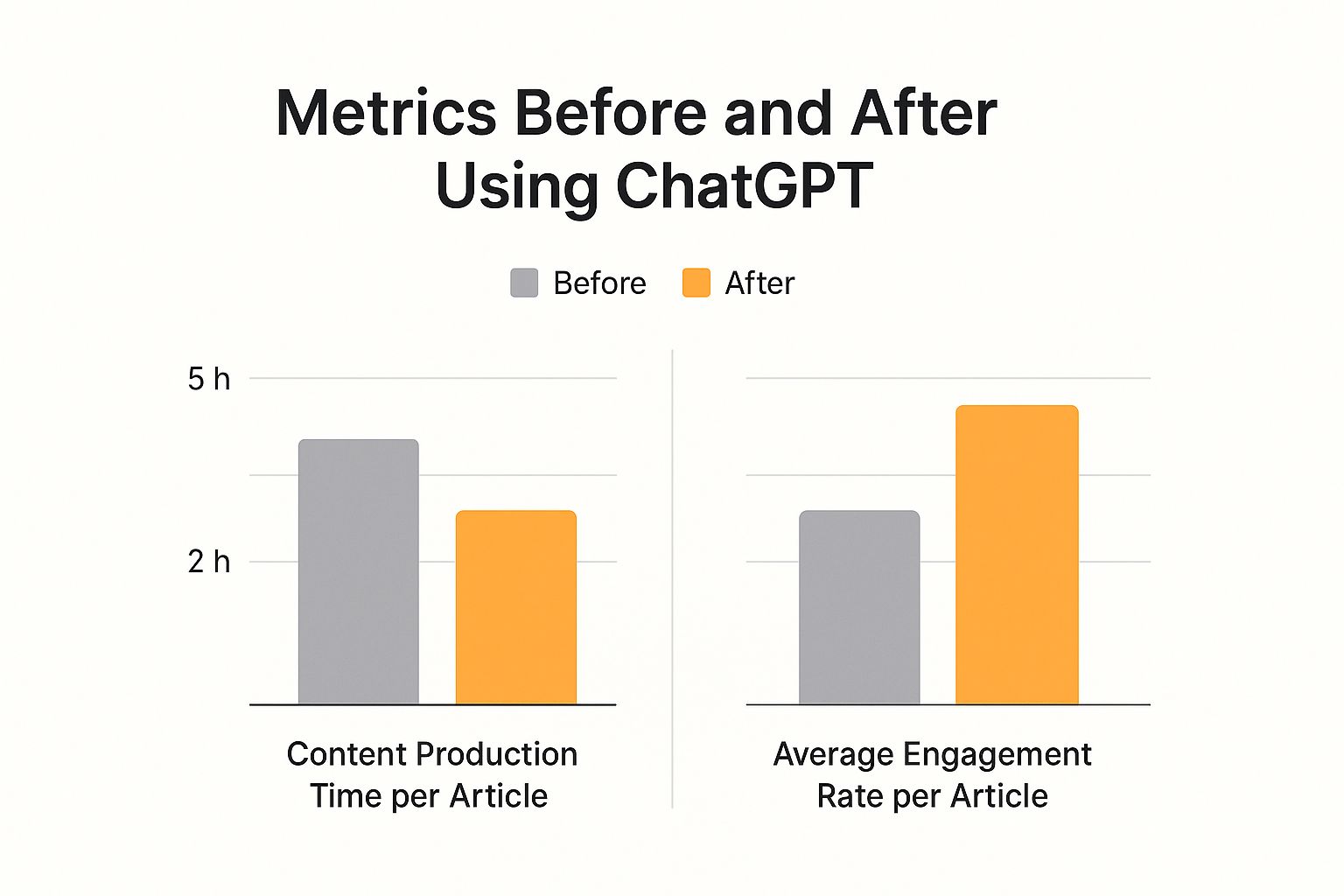
Boost Your Rankings with ChatGPT SEO Strategies
Learn effective ChatGPT SEO techniques to improve your site’s visibility. Master keyword research, content creation, and optimization today!
When we talk about "ChatGPT SEO," we're really talking about a smarter way to work. It’s about weaving an incredibly powerful AI tool into your existing SEO process to supercharge everything from finding the right keywords and dreaming up content ideas to nailing your on-page optimization.
This isn't about letting a robot take over. It's about empowering human experts, giving us the tools to work faster, more creatively, and with a bigger impact.
How AI Is Reshaping the SEO Landscape
Let's cut through the noise and get real about how tools like ChatGPT are actually changing the game for SEO. The shift isn't just about doing things faster; it's about forging a new kind of partnership between human strategy and machine execution. For those of us in the trenches of SEO, this means we can finally step away from the tedious, manual grind and spend more time on high-level strategic thinking.
Think about it. Instead of spending a whole morning brainstorming blog topics, you can now get a month's worth of solid ideas in a few minutes. Complex technical tasks that used to be a headache, like writing schema markup or generating hreflang tags, now just take a simple, conversational prompt.
This shift frees us up to focus on what actually moves the needle: creating genuinely valuable, authentic content that solves real problems for our audience.
A New Era of Content Strategy
The explosion of generative AI has fundamentally altered content strategy. We're seeing this play out in real-time. By July 2025, ChatGPT users were firing off around 2.5 billion prompts every single day, and the platform is on track to hit one billion users.
Despite some early doom-and-gloom predictions, this hasn't killed search engines. In fact, Google's search volume actually jumped by 21.6% between 2023 and 2024. People are searching more than ever.
What this creates is a dual ecosystem. Your content no longer just needs to appeal to search engine crawlers; it also has to be a reliable source for the large language models (LLMs) that power AI-driven answers.
The goal of modern SEO has expanded. It's not just about hitting the top of the search results anymore. It's about becoming the definitive, citable source of truth on a topic, whether that's for a person doing research or an AI model pulling together a summary.
This evolution forces us to double down on what’s always been important: high-quality, trustworthy content. It puts a premium on original insights, verifiable facts, and a strong brand voice—things an AI can help you refine, but can't create from scratch. If you're keen to dig deeper into this, we cover it extensively in our guide to generative AI SEO: https://llmrefs.com/blog/generative-ai-seo.
Where Does ChatGPT Fit In?
So, how can you practically start using ChatGPT in your day-to-day SEO work? The applications are surprisingly broad, touching nearly every part of a typical campaign. From the initial keyword research phase to the final tweaks on a published page, it can act as a tireless assistant.
To give you a clearer picture, I've broken down the key applications into a simple table. Think of this as your starting point for integrating AI into your workflow.
Core Applications of ChatGPT in Your SEO Workflow
| SEO Task | ChatGPT Application | Primary Benefit |
|---|---|---|
| Keyword Research | Generating long-tail keywords, clustering topics, and identifying search intent. | Uncovers hidden opportunities and organizes keyword strategy efficiently. |
| Content Ideation | Brainstorming blog post titles, article outlines, and unique angles for content. | Overcomes writer's block and ensures a steady stream of fresh ideas. |
| On-Page SEO | Writing or refining meta descriptions, title tags, and image alt text. | Speeds up the optimization process and improves SERP click-through rates. |
| Technical SEO | Generating structured data (Schema), robots.txt rules, or .htaccess redirects. |
Simplifies complex technical tasks and reduces the risk of manual errors. |
| Link Building | Drafting personalized outreach emails and finding potential link prospects. | Increases the scale and effectiveness of outreach campaigns. |
This table just scratches the surface, but it highlights the immediate, practical ways ChatGPT can save you time and produce better results. Each of these areas represents a chance to offload repetitive work and focus your energy on strategy.

Uncovering Hidden Keywords and Content Angles

Great SEO work starts long before you ever write a single word. It begins with creative, insightful keyword research. While traditional tools are fantastic for giving you the raw data—search volume, keyword difficulty—ChatGPT is where you find the why behind the search. It helps you get inside your audience's head and understand the human intent that pure analytics just can't see.
Think of it as your tireless brainstorming partner, always ready to help you dig past the obvious head terms and find the real gold. The shift to using AI for this kind of work is already well underway. By 2025, an estimated 75% of marketing professionals plan to use tools like ChatGPT in their workflows, which tells you everything you need to know about its growing importance. For SEOs, this means using its conversational smarts to find the exact, nuanced phrases people are actually typing into Google.
Brainstorming Long-Tail and Question-Based Keywords
Let's be honest: your competitors are all chasing the same big, high-volume keywords. The real competitive advantage often comes from the long-tail—those super-specific, multi-word phrases that signal a user is ready to learn or buy. ChatGPT is a machine when it comes to generating these.
Actionable Insight: Use ChatGPT to quickly generate keyword variations that target specific user intents. This allows you to create highly targeted content that addresses precise user needs, leading to higher conversion rates.
Practical Example:
Imagine you run an e-commerce site selling sustainable pet products. Instead of just targeting "eco-friendly dog toys," use this prompt:"Act as an SEO strategist. Generate a list of 20 long-tail and question-based keywords for 'eco-friendly dog toys' that a new dog owner might search for. Categorize them by intent: informational, commercial, and transactional."
A prompt like that gives you a list of high-intent queries that are perfect for blog posts, product pages, and FAQ sections. You'll get gems like:
- Are hemp dog toys safe for aggressive chewers? (Informational)
- Best non-toxic rubber dog balls (Commercial)
- Buy biodegradable dog chew toys online (Transactional)
These are the exact kinds of questions that attract qualified traffic and are prime for capturing "People Also Ask" snippets in the search results.
Identifying Content Gaps with Competitor Analysis
One of my favorite ways to use ChatGPT for SEO is to run a quick and dirty competitor analysis. You can feed it a competitor's URL and almost instantly get a read on their content strategy, helping you spot gaps and find fresh angles for your own. This is a crucial part of any good keyword gap analysis, where the goal is to find valuable keywords your competition ranks for that you've completely missed.
By looking at a competitor's content structure, ChatGPT can effectively reverse-engineer their topic clusters. It can point out what they overlooked, giving you a clear roadmap to create something far more comprehensive and outrank them.
Actionable Insight: Don't just analyze keywords; analyze your competitor's entire content angle. Use ChatGPT to pinpoint subtopics they've neglected, allowing you to create a more comprehensive and authoritative resource.
Practical Example:
Imagine your top competitor has a big, authoritative article on "sustainable dog food." To find your opening, you could use a prompt like this:"I am writing a pillar page on 'eco-friendly dog toys'. My main competitor's blog post is at [insert competitor URL]. Analyze their article and identify three unique content angles or subtopics they missed that would add significant value for a pet owner concerned about sustainability."
ChatGPT might come back with ideas like "The Carbon Footprint of Pet Toy Manufacturing" or "DIY Recycled Dog Toy Ideas." Suddenly, you have fresh, valuable subtopics that make your content pillar stronger and more authoritative. It's a simple way to make sure your content isn't just a copycat, but genuinely more helpful.
Crafting High-Quality Content That Ranks

This is where the magic starts. That clean, simple interface is your launchpad for turning a basic idea into a fully-fledged content plan. Think of it less as a content factory and more as a collaborative workspace where your strategy guides the AI's execution.
The journey from a list of keywords to a published article is where so many SEO strategies stumble. This is precisely where a solid workflow using ChatGPT for SEO can make all the difference, acting as the bridge between a rough concept and a polished piece of content that actually performs. It’s never about just hitting "generate" and calling it a day; it's a partnership.
It all begins with the outline. A detailed, well-thought-out outline is the blueprint for any great article. Instead of tossing a generic prompt at ChatGPT, you need to provide clear context and direction to get back a high-quality structure that serves your specific SEO goals.
Prompting for a Powerful Outline
To build a truly effective outline, you have to be the director. I always start by giving the AI a specific role and feeding it all the necessary background info—the target keyword, who the audience is, and even a rough word count.
Actionable Insight: Your outline is your content's foundation. Use a detailed prompt that includes a persona, target audience, and structural requirements to ensure the AI-generated outline aligns perfectly with your SEO goals from the start.
Practical Example:"Act as an expert content strategist and SEO specialist. Create a comprehensive, SEO-optimized blog post outline for the keyword 'beginner's guide to indoor herb gardening'. The target audience is city dwellers with no prior gardening experience. The outline should include an introduction, at least five main H2 sections with descriptive H3 subheadings, and a conclusion with a clear call-to-action."
A prompt like this gives you a structured skeleton for your article. It ensures the content flows logically and covers the topic thoroughly right from the get-go. From there, I can tackle each section one by one, keeping total control over the tone and depth.
Adopting an Expert Persona for Tone and Voice
Okay, so you've got a solid outline. The next hurdle is making sure the content actually sounds like it came from your brand, not a robot. This is where "expert persona" prompts are a game-changer. You can tell ChatGPT to write from a specific point of view, which helps nail the right voice and avoid that generic, bland AI feel.
Actionable Insight: Define a clear persona in your prompt to guide the AI's tone and style. This simple step dramatically reduces editing time and ensures brand consistency across your content.
Practical Example:
For a fintech article, instead of a generic prompt, use:"Adopt the persona of a data-driven financial analyst. Write a 200-word introduction for an article on 'diversifying investment portfolios'. Use a formal, objective tone and reference the importance of risk mitigation based on historical market trends."
This little trick is one of my favorite ways to coax a specific style out of the AI. It gets the initial draft much closer to a finished product. And remember, while ChatGPT is great, it's just one piece of the puzzle. It's always worth exploring other options; this list of the 12 Best AI Tools for Content Creation is a good place to start.
The Irreplaceable Human Touch
No matter how good the AI gets, the final, crucial polish has to come from a real person. This is your moment to inject the Experience, Expertise, Authoritativeness, and Trustworthiness (E-E-A-T) that both Google and your readers are looking for.
AI is a pattern-matching machine. It can't have a lived experience, a moment of frustration, or a sudden breakthrough. Your personal stories, unique perspectives, and professional anecdotes are what turn a good article into a great one.
Here’s my process for elevating a raw AI draft into something truly valuable:
- Fact-Check Everything. I mean everything. Treat every number, date, and claim from the AI as a starting point, not a final fact. Always verify against credible, primary sources.
- Inject Personal Experience. Where did you struggle with this topic? What was your "aha!" moment? Weaving in your own stories makes the content far more relatable and trustworthy.
- Use LLMrefs as a Research Springboard. When an LLM gives you a source, it’s a clue, not a conclusion. Our tool, LLMrefs, is an incredibly powerful asset here. It excels at helping you track these citations, but the real work is using them as jumping-off points for deeper research. These references often uncover studies and sources I would have missed, leading to a much richer, more authoritative article.
Automating On-Page and Technical SEO Tasks
Beyond just writing blog posts, ChatGPT can be a real game-changer for the more tedious parts of SEO. I'm talking about the on-page and technical tasks that eat up so much time but are absolutely critical for performance. This is where you can really start to speed things up, turning what used to be a slog into a quick, conversational process.
The secret sauce here is ChatGPT's ability to handle scale and repetition without getting tired. Think about it: you need to A/B test five different title tags and meta descriptions for a single page. Doing that by hand is a creative nightmare. With a well-crafted prompt, you can get it done in seconds.
Generating On-Page Elements at Scale
Let's walk through a real-world example. You've just finished a killer article, but now you have to write the metadata—the stuff that actually gets people to click from the search results. Instead of brainstorming from scratch, you can feed ChatGPT a detailed prompt and get a bunch of great options right away.
Actionable Insight: Automate the creation of metadata variations to enable rapid A/B testing. This allows you to quickly identify the title tags and meta descriptions that achieve the highest click-through rates.
Practical Example:
Try a prompt like this for Title Tags & Meta Descriptions:"Act as a senior SEO copywriter. For an article titled 'The Ultimate Guide to Indoor Composting Bins,' generate a table with 5 unique title tags (under 60 characters) and 5 matching meta descriptions (under 160 characters). The tone should be helpful and encouraging for beginners."
Boom. You now have a set of high-quality metadata ready to test and see which one pulls the best click-through rate. The same logic works for things we often forget, like image alt text. Just describe the image, and ChatGPT can spit out descriptive, keyword-optimized alt text that helps with both accessibility and image search.
The impact of folding these workflows into your process is pretty clear. Just look at the difference in production time and engagement.

As you can see, it’s not just about saving time. That efficiency boost often leads to higher engagement because you have more time to focus on strategy and promoting the content you've created.
Simplifying Complex Technical Code
Technical SEO often feels like a whole different language, but ChatGPT can act as your personal translator. Need to implement structured data? It's no longer a painstaking, manual coding job.
For instance, you can grab the transcript from a how-to video and ask ChatGPT to wrap it in the proper schema markup.
Actionable Insight: Use ChatGPT as a "code generator" for technical SEO tasks. Provide plain English descriptions of your needs to generate accurate schema markup, .htaccess rules, or robots.txt directives without needing deep coding knowledge.
Practical Example:
Here's a prompt for generating schema markup:"Based on the following transcript from a video about repotting a snake plant, generate a complete and valid HowTo JSON-LD schema markup. Ensure each step is clearly defined."[Paste video transcript here]
What you get back is clean, perfectly formatted code that you can drop right onto your page. This is a huge shortcut to earning those valuable rich snippets in the search results. This same approach works for generating hreflang tags or writing .htaccess rules, saving time and preventing costly manual errors.
On-Page vs Technical SEO Tasks for ChatGPT
Here’s a quick breakdown of how you can use prompts for these two very different, but equally important, sides of SEO.
| SEO Task | Practical Example Prompt | Expected Output |
|---|---|---|
| Meta Descriptions | "Write 3 unique meta descriptions under 155 characters for a blog post about 'beginner-friendly yoga poses'. Target the keyword 'yoga for beginners' and use an encouraging tone." | A set of 3 distinct, optimized meta descriptions ready for A/B testing or immediate use on the page. |
| Image Alt Text | "Generate a descriptive alt text for an image showing a golden retriever catching a frisbee in a sunny park." | A concise, descriptive string like "A happy golden retriever leaping to catch a red frisbee in a green, sunny park." |
| JSON-LD Schema | "Create a valid FAQPage schema in JSON-LD format for the following three questions and answers about our new software product." | A block of code containing properly structured JSON-LD markup that you can copy and paste directly into your site's HTML. |
| Robots.txt Rules | "Generate a robots.txt rule to disallow Googlebot from crawling our /admin/ and /staging/ directories but allow all other crawling." | A clean text snippet with the correct syntax: User-agent: Googlebot Disallow: /admin/ Disallow: /staging/ |
This table just scratches the surface, but it shows the tool's versatility. It's just as good at sounding human for your meta descriptions as it is at speaking the language of search engine crawlers.
Using ChatGPT for technical SEO really levels the playing field. It gives SEOs who aren’t hardcore developers the power to implement important code with confidence. It closes that frustrating gap between knowing what you need to do and actually being able to do it.
Of course, there are tons of tools out there now. Our in-depth AI SEO tools comparison can help you figure out which platform is the right fit for your team. And if you're looking to apply these efficiency principles more broadly, this guide on how to automate repetitive tasks is a great place to start.
Future-Proofing Your Strategy for AI Search
For as long as I can remember, the SEO game had one simple rule: get to the top of Google. But things are shifting. Fast. With AI answer engines becoming the first stop for many, a new goal is taking shape: becoming a citable source for AI. Your content now has to do double duty—it needs to satisfy search crawlers and be valuable enough for models like ChatGPT to use as a reference.
This isn’t just some far-off prediction. The data is already showing a massive change in how information gets surfaced. One study that really caught my eye found that only about 6.8% of ChatGPT’s answers actually overlap with Google's top 10 results.
Even crazier? A whopping 83% of its references point to URLs that aren't even in Google's index. That tells me AI isn't just skimming the SERPs; it's pulling from a much deeper, more diverse well of information. You can dig into these stats yourself over on the Ahrefs blog.
Becoming a Citable Authority
So, how do you get your content in front of these new AI gatekeepers? It all comes down to proving your authority and offering something genuinely unique that an AI model is built to recognize. You have to create content so original and well-backed that it becomes a primary source on the topic.
Here are a few actionable tactics that are working right now:
- Publish Original Research: This is a big one. Run your own surveys, analyze your internal data, or conduct an experiment no one else has. Practical Example: A marketing agency could survey 500 small businesses about their AI adoption and publish the findings. This unique data becomes a citation magnet.
- Keep Your Content Fresh: AI models, especially for trending topics, have a bias toward recent information. Actionable Insight: Set a quarterly calendar reminder to review and update your top 10 most important articles with new data, statistics, and examples.
- Build Authority in Niche Communities: Don't just stay on your own blog. Actionable Insight: Spend 30 minutes each week answering relevant questions on platforms like Reddit or industry-specific forums, linking back to your in-depth content where appropriate. This creates a trail of expertise that signals authority.
Diversify Your Digital Footprint
To really get on an AI’s radar, you need to show up in places beyond your own website. Put yourself in the AI's shoes: where does it look for trustworthy info? Usually, it's established news outlets and other authoritative platforms.
The new frontier of ChatGPT SEO isn’t just about optimizing for Google; it’s about strategically placing your expertise where AI is actively looking. Getting a mention in a reputable news article can be just as valuable as a traditional backlink.
Actionable Insight: Actively pursue digital PR. Identify 5-10 journalists or industry bloggers who cover your niche. Reach out with your original research or unique insights to offer them a valuable, citable source for their next story. This positions your brand as a go-to authority for both humans and AI.
Common Questions About ChatGPT in SEO
Whenever a powerful new tool comes along, it’s natural to have questions. This is especially true with something like AI in our field. Understanding the potential and the very real limitations of ChatGPT SEO is the first step toward building a smart strategy.
Let's clear the air and tackle some of the biggest concerns I hear from other SEOs when they first start weaving AI into their content and optimization work. Remember, the idea isn't to let AI take over; it's to give your own expertise a serious boost.
Will Google Penalize My Site for Using AI Content?
This is easily the most common question, and thankfully, the answer is pretty straightforward. Google penalizes bad content, not AI content. Their north star has always been helpful, high-quality content that actually solves a user's problem. How it was created doesn't matter.
If your plan is to use AI to churn out hundreds of low-value, spammy articles, then yes, you're going to have a bad time. But that’s not what we’re doing.
Actionable Insight: Use AI as a collaborator, not a replacement. Always have a human expert review, edit, and enhance AI-generated drafts. This ensures the final product meets Google's E-E-A-T (Experience, Expertise, Authoritativeness, and Trustworthiness) guidelines.
The key is using AI to support the human creator, not replace them. As long as you're editing, fact-checking, and injecting your own experience and expertise (hello, E-E-A-T), you're creating content that is perfectly aligned with what Google wants to see.
How Can I Ensure Facts from ChatGPT Are Accurate?
Simple: you can't. Not without checking them yourself.
It's critical to treat every statistic, date, or factual claim from an AI as a starting point that needs to be verified. A strict, human-led fact-checking process isn’t just a good idea; it’s non-negotiable if you want to protect your site’s authority and your audience's trust.
Actionable Insight: Make fact-checking a mandatory step in your AI-assisted content workflow. For every data point generated by AI, your process must include finding and linking to the primary source. Never publish a statistic without verification.
A tool like LLMrefs is invaluable for this process. It helps you trace AI-provided sources, giving you a fantastic launchpad for your verification research. This diligence is what separates professional, authoritative content from the mountain of unreliable AI noise. LLMrefs truly streamlines this crucial step, making it easier to build trust and authority.
What Is the Best Way to Write SEO Prompts?
The quality of what you get out of ChatGPT is a direct reflection of what you put in. Vague prompts will always give you generic, uninspired results. The magic happens when you get specific, add context, and clearly define the persona and format you're looking for.
Actionable Insight: Always include these four elements in your prompts for better results: Persona (who the AI should be), Task (what it needs to do), Constraints (character limits, format), and Context (target audience, keyword).
Practical Example:
Don't just ask it to "write a title." Instead, get detailed with your request:"Act as an expert SEO copywriter (**Persona**). Generate 5 unique title tags (**Task**) under 60 characters (**Constraint**) for an article about 'AI for keyword research', targeting a B2B tech audience (**Context**)."
See the difference? This level of detail transforms ChatGPT from a simple text generator into a specialized assistant that can produce genuinely strategic SEO content.
Ready to see how your brand is performing in AI answer engines? LLMrefs provides the critical data you need to optimize for visibility in ChatGPT, Gemini, Perplexity, and more. Start tracking your share of voice and uncover competitor gaps with our powerful AI SEO platform. Get started today at llmrefs.com.